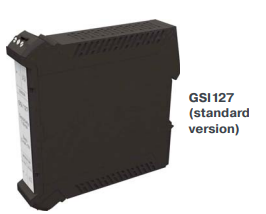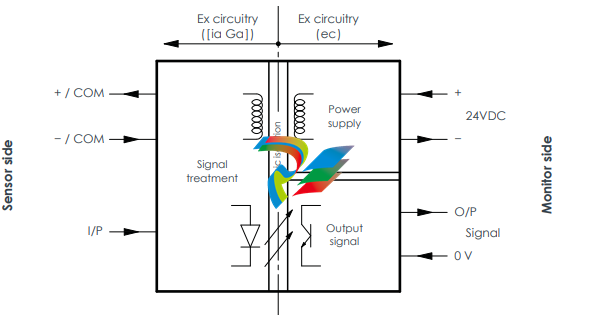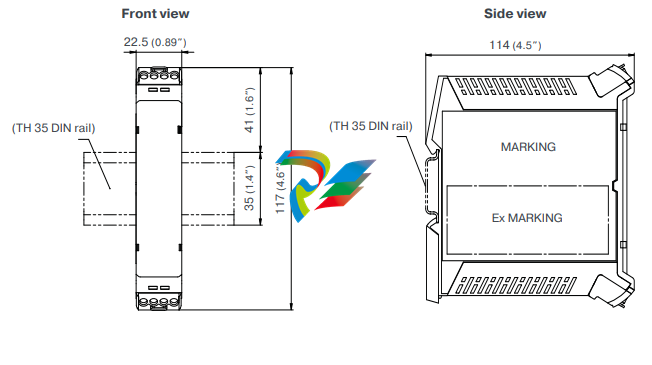
Vibro-meterGSI127 galvanic separation unit

KEY FEATURES AND BENEFITS
• From the vibro-meter ® product line
• Power supply for sensors and/or signal
conditioners with a current output or a
voltage output
• 4 kVRMS galvanic separation between the
sensor side and the monitor side
• 50 VRMS galvanic separation between the
power supply and the output signal
(floating output)
• High rejection of frame voltage
• μA to mV transfer function for current-signal
transmission over longer distances
• V to V transfer function for voltage-signal
transmission over shorter distances
• Available in standard versions and Ex versions
certified for use in potentially explosive
atmospheres (hazardous areas)
• Compatible with all vibro-meter
sensors / measurement chains
• Also compatible with industry-standard IEPE
sensors and 4 to 20 mA loop-powered sensors,
including vibration sensors/transmitters
• No ground connection needed
KEY BENEFITS AND FEATURES (cont’d)
• Suitable for use in functional safety contexts:
SIL 2 in accordance with IEC 61508
• Removable screw-terminal connectors
• DIN-rail mounting
APPLICATIONS
• All vibro-meter sensors / measurement chains
• Safety-related applications
DESCRIPTION
The GSI127 is a galvanic separation unit from
Parker Meggitt’s vibro-meter ® product line. It is
designed for operation with the signal conditioners,
charge amplifiers and electronics (attached or
integrated) used by various vibro-meter
measurement chains and/or sensors.
Compatible devices include the IPC707 signal
conditioners (charge amplifiers) used by CAxxx
piezoelectric accelerometers and CPxxx dynamic
pressure sensors (and older IPC704 signal
conditioners), the IQS9xx signal conditioners used by
TQ9xx proximity sensors (and older IQS4xx signal …
Information contained in this document may be subject to export control regulations of the European Union, USA or other countries. Each
recipient of this document is responsible for ensuring that the transfer or use of any information contained in this document complies with all
relevant export control regulations. ECN N/A.
DESCRIPTION (continued)
conditioners), the attached or integrated electronics
used by CExxx piezoelectric accelerometers, and the
integrated electronics used by the VE210 velocity
sensor. The GSI127 is also compatible with industrystandard IEPE (integrated electronics piezo electric)
sensors such as the CE620, CE630 and PV660
vibration sensors, and 4 to 20 mA loop-powered
sensors such as the CE687 and PV685 vibration
sensors.
Note: The variant of the GSI127 defined by the
ordering option code B11 is compatible with IQS91x
signal conditioners and/or industry-standard
4 to 20 mA loop-powered sensors/transmitters.
The GSI127 galvanic separation unit is a versatile unit
that can be used for the transmission of highfrequency AC signals over long distances in
measurement chains using current-signal
transmission or as a safety barrier unit in
measurement chains using voltage-signal
transmission. More generally, it may be used to
supply any electronic system (sensor side) having a
consumption of up to 21 mA.
The GSI127 also rejects a large amount of the frame
voltage that can introduce noise into a measurement
chain. (Frame voltage is the ground noise and AC
noise pickup that can occur between the sensor case
(sensor ground) and the monitoring system
(electronic ground)). In addition, the design of its
internal power supply results in a floating output
signal, thereby eliminating the need for an additional
external power supply such as a APF19x.
Ex versions of the GSI127 are certified to be installed
in an Ex Zone 2 (“Ex ec”) when supplying
measurement chains installed in Ex environments up
to Zone 0 (“[ ia Ga ]”). These units can also eliminate
the need for additional external Zener barriers.
The GSI127 housing features removable screwterminal connectors that can unplugged from the
main body of the housing to simplify installation and
mounting. It also features a DIN-rail mounting
adaptor for direct mounting on a DIN rail.
In addition, the GSI127 incorporates diagnostics that
automatically and remotely indicates the health/
status of the measurement chain so you always know
when measurements can be trusted. The diagnostics
(SIL 2 “by design”) bring enhanced reliability and
significant risk reduction, making the GSI127 suitable
for use in safety-related applications (functional
safety contexts).
For specific applications, contact your local
Parker Meggitt representative.
BLOCK DIAGRAM

SPECIFICATIONS
Environmental
General
Temperature
• Operating : −20 to 70°C (−4 to 158°F)
• Storage : −40 to 85°C (−40 to 185°F)
Humidity
• Operating : 90% max. non-condensing
• Storage : 95% max. non-condensing
Protection rating
(according to IEC 60529)
: IP20.
Note: The GSI127 is suitable for indoor use only unless it is installed in
an industrial housing or enclosure that ensures a higher level of
environmental protection.
Vibration
(according to IEC 60068-2-6)
: 2 g peak above resonant frequency and 0.35 mm peak below
(10 to 55 Hz, 6 hours/axis)
Shock acceleration
(according to IEC 60068-2-27)
: 15 g peak
(half sine impulse, 11 ms duration, 3 shocks/axis)
Altitude : 4000 m (13100 ft) max.
Note: Reduced air density affects cooling ability.
Potentially explosive atmospheres (ordering option code A2)
Available in Ex approved versions for use in hazardous areas

*UKCA marking is not engraved/marked on the product.
For specific parameters of the mode of protection concerned and special conditions for safe use,
refer to the Ex certificates that are available from Parker Meggitt.
When using protection mode “Ex ec” (increased safety), the user must ensure that the GSI127 is
installed in an industrial housing or enclosure that ensures a protection rating of at least IP54
(or equivalent).
For the most recent information on the Ex certifications that are applicable to this product,
refer to the Ex product register (PL-1511) document that is available from Parker Meggitt.
Note: Some certifications and approvals are pending!
SPECIFICATIONS (continued)
Approvals
Conformity : European Union (EU) declaration of conformity (CE marking)
Electromagnetic compatibility
(EMC)
: EMC compliant (2014/30/EU):
EN 61000-6-2:2005.
EN 61000-6-4:2007 + A1:2011.
Electrical safety : EN 61010-1:2010
Environmental management : RoHS compliant (2011/65/EU)
Hazardous areas : Ex approved versions
(see Potentially explosive atmospheres on page 3)
Functional safety : SIL 2 in accordance with IEC 61508
Note: Some certifications and approvals are pending!
Electrical
Power supply (to GSI127)
Input voltage range : 24 VDC nominal (20 to 28 VDC)
Power consumption : <3.1 W
Current consumption : <130 mA (with 24 VDC power supply)
Overvoltage protection : >30 VDC
Supply impedance (sensor side)
• Ordering option codes B01-B11 : <30 Ω
• Ordering option code B21 : >50 kΩ
Note: The GSI127 should be powered (energized) using a limited-power, low-voltage power supply such as a
APFxxx 24 VDC power supply or other suitable power supply unit.
In safety-related applications, a GSI127 must be powered using a limited-power, low-voltage power supply with a safe
limitation of 60 VDC (nominal), even in the event of a single fault with the power supply.
Input signal (sensor side)
Supply (to measurement chain)
• Ordering option codes B01-B03
and B11
: 20 VDC ±1 VDC / 21 to 30 mADC.
Note: 30 mADC is the maximum (short-circuit) current.
• Ordering option code B04 : 21 VDC ±1 VDC / 20 to 30 mADC.
Note: 30 mADC is the maximum (short-circuit) current.
• Ordering option code B05 : −21 VDC ±1 VDC / 20 to 30 mADC.
Note: 30 mADC is the maximum (short-circuit) current.
• Ordering option code B21 : 8 mADC ± 0.5 mADC / 22 to 30 VDC.
Note: 30 VDC is the maximum (open-circuit) voltage.
Input dynamic range
• Ordering option codes B01-B03
and B11
: 2 to 20.75 mADC
• Ordering option code B04 : 1.3 to 19 VDC
• Ordering option code B05 : −1.3 to −19 VDC
• Ordering option code B21 : 1.3 to 20.3 VDC
SPECIFICATIONS (continued)
Output signal (monitor side)
Output voltage dynamic range
(with 10 kΩ load)
: 0.8 to 20.8 VDC
Output impedance : <30 Ω, protected against short-circuits
Power supply voltage rejection ratio (PSRR)
• 10 Hz to 400 Hz : ≥60 dB
• 400 Hz to 20 kHz : ≥46 dB
Transfer characteristics
Galvanic separation
• Sensor side and monitor side : 4 kVRMS
• Power supply and output signal : 50 VRMS
Sensitivity and offset (zero)
• Ordering option code B01 : 1 V/mA and 2 VDC
• Ordering option code B02 : 1 V/mA and −5 VDC
• Ordering option code B03 : 3.2 V/mA and −48 VDC
• Ordering option code B04 : 1 V/V and 0 VDC
• Ordering option code B05 : −1 V/V and 0 VDC
• Ordering option code B11 : 0.5 V/mA and 0 VDC
• Ordering option code B21 : 1 V/V and 0 VDC
Note: See also Accuracy, Output offset and other parameters in
DC transfer on page 5, and AC transfer on page 6.
Transfer function : Output value = (Input value × Sensitivity) + Offset
Where:
Output value is the value of the analog voltage output signal from the
GSI127.
Input value is the value of the analog input signal (current or voltage) to
the GSI127.
Sensitivity is the transfer sensitivity for a particular variant of the GSI127,
as defined by the ordering option code.
Offset is the output offset for a particular variant of the GSI127,
as defined by the ordering option code.
DC transfer
Accuracy : ±1% (at ambient temperature)
Sensitivity drift : ±50 ppm/°C (over operating temperature range)
Linearity error
(best straight-line INL)
: <0.2%
Output offset
(middle of DC range)
: ±200 mVDC
Output offset drift
(middle of DC range)
: ±2 mV/°C (over operating temperature range)
SPECIFICATIONS (continued)
AC transfer
Bandwidth
• Frequency band (±0.5 dB) : DC to 20 kHz
• −3 dB cut-off frequency (typical) : 30 kHz
Accuracy : ±0.5 dB (over bandwidth from DC to 20 kHz)
Linearity error
(total harmonic distortion (THD))
: <−46 dB (0.5%) (over bandwidth from DC to 20 kHz)
Full-scale dynamic signal to noise ratio
(SNRFSD)
: >80 dB (from 10 to 2 kHz)
Connectors
Screw-terminal connector
(input, top)
: 4 contacts for sensor-side signals
Screw-terminal connector
(output, bottom)
: 4 contacts for monitor-side signals
Electrical connections
• IEC : 400 V / 0.2 to 2.5 mm2
• UL : 300 V / 10 A / 26 to 12 AWG
Clamping range (min. to max.) : 0.2 to 2.5 mm2 (26 to 12 AWG)
Tightening torque (min. to max.) : 0.4 to 0.6 N•m (0.30 to 0.44 lb-ft)
Note: The GSI127 features removal screw-terminal connectors that can unplugged from the main body of its housing to
simplify installation and mounting.
Physical
Mounting : Suitable for TH 35 DIN rails (according to EN 50022 / IEC 60715).
For example, TH 35-7.5 or TH 35-15.
Electrical connections : Removable screw-terminal connectors (see Connectors on page 6)
Housing
• Material : Polyamide (PA 66 GF 30)
• Color : Standard versions: Gray.
Ex approved versions: Gray with the electrical connections to the sensor
side indicated by blue.
Dimensions : See Mechanical drawings on page 7
Weight : 140 g (0.31 lb) approx.
MECHANICAL DRAWINGS

Notes
All dimensions are in mm (in) unless otherwise stated.
For standard versions of the GSI127, the housing is completely gray in color.
For Ex approved versions of the GSI127, the housing is gray in color but with a screw-terminal connector (top) for sensor-side signals (electrical connections) that is blue in color.
ORDERING INFORMATION
To order please specify
Type Designation Part number (PNR)
GSI127 Galvanic separation unit

Notes
1. Only CExxx piezoelectric accelerometers with a current output signal require a GSI127.
For example, CE134, CE281 and CE31x piezoelectric accelerometers.
2. A IPCxxx signal conditioner or VE210 velocity sensor with a current output signal is
typically used for signal transmission over longer distances. For example, IPC707.
Note: For a IPC707 without diagnostics, the nominal current output signal (DC) is
12 mA (→ 7 V). For a IPC707 with diagnostics, the nominal current output signal (DC) is
13 mA (→ 8 V). Refer to the IPC707 data sheet for further information.
3. A IQS90x (or IQS4xx) signal conditioner with a current output signal is typically used for
signal transmission over longer distances. For example, IQS900.
4. A IPCxxx signal conditioner with a voltage output signal is typically used for signal
transmission over shorter distances. For example, IPC707.
Note: For a IPC707 without diagnostics, the nominal voltage output signal (DC) is
7 V. For a IPC707 with diagnostics, the nominal voltage output signal (DC) is 8 V.
Refer to the IPC707 data sheet for further information.
5. A IQS90x (or IQS4xx) signal conditioner or VE210 velocity sensor with a voltage output
signal is typically used for signal transmission over shorter distances. For example,
IQS900.
6. For use with IQS910 signal conditioner (“transmitter” with a 4 to 20 mA current-loop
signal) or industry-standard 4 to 20 mA loop-powered sensors, that is, current-loop
sensors/transmitters. For example, CE687 and PV685 vibration sensors.
7. For use with industry-standard IEPE (integrated electronics piezo electric) sensors,
that is, constant-current voltage-output sensors. For example, CE620, CE630 and PV660
vibration sensors.




























































































































